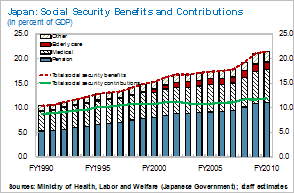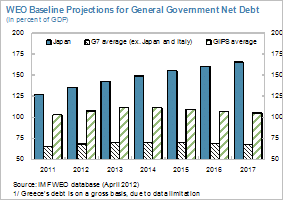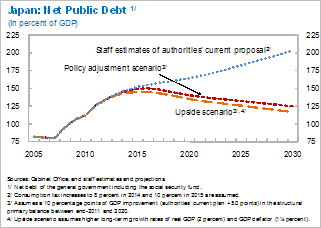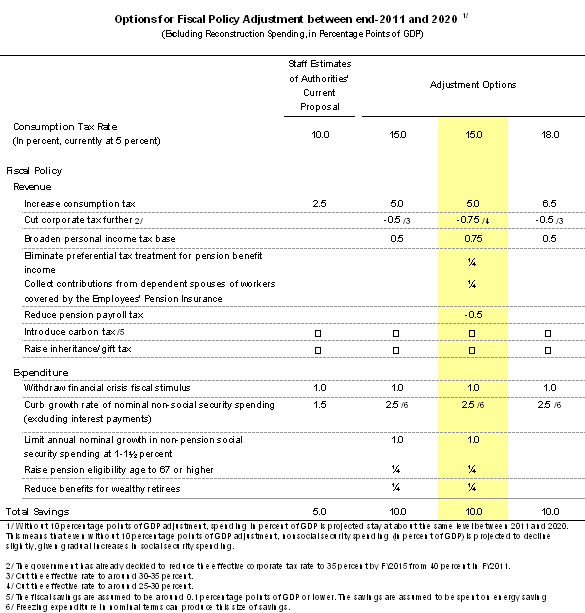2012 Article IV Consultation with Japan: Concluding Statement of the IMF Mission
June 12, 2012
Describes the preliminary findings of IMF staff at the conclusion of certain missions (official staff visits, in most cases to member countries). Missions are undertaken as part of regular (usually annual) consultations under Article IV of the IMF's Articles of Agreement, in the context of a request to use IMF resources (borrow from the IMF), as part of discussions of staff monitored programs, and as part of other staff reviews of economic developments.
June 12, 2012
The Japanese economy has shown remarkable resilience and adaptability in the aftermath of the Great East Japan earthquake and is now experiencing a recovery. Risks, however, have shifted decidedly to the downside, with the turmoil in Europe intensifying and other advanced and key emerging market economies showing signs of slowing. Moreover, to address the longstanding challenges of high public debt, low growth, and deflation, Japan needs to move forcefully on many fronts to take advantage of synergies among policies. The immediate priority is passage of the current tax and social security reform, which would bolster confidence and help create a more conducive environment for monetary easing. It would also help maintain financial sector stability, given increased fiscal and financial sector linkages. An exit from deflation and accelerated structural reforms would raise growth and support fiscal adjustment. This statement summarizes the findings of the Article IV consultation and the recent Financial Sector Assessment Program (FSAP) Update.
I. Outlook and Risks
1. Despite the devastation of the earthquake and tsunami, the impact on growth proved to be shortlived. Real GDP declined by ¾ percent in 2011 but grew at an annualized rate of 4¾ percent in the first quarter of 2012. Moreover, the financial sector has remained stable and the current account has continued to record a sizeable surplus.
2. Looking ahead, reconstruction will drive the recovery. Growth is expected to reach about 2 percent in 2012 supported by public reconstruction spending of around 1½ percent of GDP and a recovery in consumer demand (text table). A weak external environment, especially in Europe, is likely to dampen demand for exports and weigh on business sentiment. For 2013, real GDP growth is projected to slow slightly to 1¾ percent as reconstruction winds down. While headline inflation has risen modestly, IMF staff expect inflation to remain around zero in the next two years, under current policies, as a result of the still wide output gap and declining commodity prices.
3. Risks to the outlook have shifted decidedly to the downside. An escalation of the European turmoil or a sharper-than-expected slowing of the Chinese economy would hurt Japanese exports and growth. Moreover, an intensification of the flight to safety in financial markets could lead to exchange rate volatility, further appreciate the yen and depress equity prices and business and consumer confidence. With the complete closure of all nuclear plants, an unusually hot summer could disrupt economic activity. This risk would be mitigated, however, by the extent of conservation efforts already being taken. On the upside, a faster than expected recovery in Japanese consumer and business sentiment would lift domestic demand, while a reopening of some nuclear power plants would limit the disruption in economic activity.
| 2010 | 2011 | 2012 | 2013 | |
| (Calendar Year, Growth Rate) | ||||
|
Real GDP |
4.4 | -0.7 | 2.0 | 1.7 |
|
Total domestic demand |
2.7 | 0.1 | 2.4 | 1.4 |
|
Net exports (contribution) |
1.7 | -0.8 | -0.3 | 0.3 |
|
CPI inflation (average) |
-0.7 | -0.3 | 0.0 | 0.0 |
|
Current account balance (in percent of GDP) |
3.6 | 2.0 | 2.2 | 2.7 |
|
General government primary balance |
-8.7 | -9.1 | -8.9 | -7.5 |
|
Gross debt (in percent of GDP) |
215.3 | 229.7 | 235.8 | 241.1 |
|
Net debt (in percent of GDP) |
112.8 | 126.6 | 135.2 | 142.7 |
|
Source: IMF staff estimates. | ||||
|
Table 1. Japan: Near-Term Projections
II. Securing Fiscal Sustainability4. Japan’s fiscal problems are deep rooted. Net public debt has increased nearly ten-fold over the last two decades to more than 125 percent of GDP. As a result of population aging, social security spending has risen rapidly (text figure), while persistently weak growth and deflation have depressed tax revenues.  5. Addressing Japan’s fiscal vulnerabilities will require sustained adjustment and bold efforts to raise long-term growth. Japan’s net public debt is higher than in almost all other advanced countries and is expected to rise further in the absence of fiscal consolidation (text figure). Even a relatively small increase in the sovereign risk premium would make fiscal consolidation more difficult, pose challenges to financial institutions, harm growth prospects in Japan, and could spill over to global risk premia and growth. In this regard, Europe’s recent experience offers a cautionary tale. Once market confidence is lost, regaining it becomes very difficult. At the same time, a large adjustment without growth is extremely difficult to implement given economic and political constraints, highlighting the need for forceful structural reforms.  6. IMF staff fully support the government’s plan to raise the consumption tax rate. Passage of legislation to double the rate to 10 percent in stages by 2015 is crucial to demonstrate a commitment to fiscal reform and sustain investor confidence. IMF staff estimate that the authorities’ current plan, including the increase in the consumption tax, the withdrawal of the financial crisis stimulus, and planned curbs to non-social security fiscal spending will achieve a 5 percent of GDP improvement in the structural primary balance by 2020. 7. Nonetheless, reducing debt to sustainable levels will require further measures. IMF staff would advise an additional 5 percent of GDP adjustment on top of current plans to achieve an overall fiscal consolidation of 10 percent of GDP over the next decade. This would achieve a primary surplus of about 3 percent of GDP by the early 2020s and put the public-debt-to-GDP ratio on a clear downward path, consistent with the authorities’ goal. IMF staff would recommend expenditure restraint of 2½ percent of GDP over the next decade by curbing growth in nominal spending. In addition, adopting a clear timeframe for further revenue increases beyond 2015 would bolster confidence in public finances (see text table, shaded column). 8. Careful design of these measures could limit their impact on growth. Building on the proposed consumption tax increase, a broad range of reforms is needed to contain social security spending, improve incentives to work and invest, and address equity concerns. While the design of an appropriate fiscal package would need to take a pragmatic approach, some elements could include the following, many of which have already been debated publicly (quantified in text table):
9. The payoff of these reforms in the form of a lower public-debt-to-GDP ratio could be sizeable. By steadily improving the fiscal balance over the course of a decade, IMF staff project net public debt to stabilize at around 150 percent of GDP by mid decade and then fall gradually to 125 percent of GDP by 2030 (text chart, policy adjustment scenario). The benefits would be larger in an upside scenario similar to the authorities’ Growth Strategy scenario, in which forceful structural reforms together with increased confidence in fiscal sustainability are assumed to lead to higher real growth and inflation. This would push down the net public-debt-to-GDP ratio to around 115 percent of GDP by 2030.  10. To sustain a decade long adjustment, a more robust fiscal framework could improve discipline and enhance public understanding of the needed reforms. Various options include adopting a medium-term budget framework with a strict overall spending limit and ministry-by-ministry spending targets, while restricting the use of supplementary budgets. Greater disclosure of tax expenditures would also increase transparency. Once fiscal consolidation is on track, the authorities could also consider adopting a legally-binding fiscal rule that could target a primary surplus.
III. Raising Growth Through Structural Reforms11. Higher growth is needed to reduce public debt and improve resilience to shocks. While Japan had one of the highest rates of productivity growth among advanced economies over the past decade, a decline in the working age population and weak investment slowed overall growth. Looking ahead, this demographic effect will continue as the population is expected to age quicker than in most other countries. To address this challenge, a bold and comprehensive package of reforms is necessary to achieve the authorities’ goal of raising growth from 1 to 2 percent, and thereby help reduce the public debt-to-GDP ratio. While achieving such an increase would be ambitious, international evidence shows that since 1980 several other advanced economies (including Canada, Finland, the Netherlands, New Zealand, and Sweden) have succeeded in raising their growth rates by a similar amount for a sustained period. 12. Reforms would focus on the most important constraints to growth. These include the decline in the labor supply with aging, low female labor force participation, domestic sector regulations, and limited availability of risk capital. A package of far-reaching structural policies include the following, many of which are currently under consideration:
IV. Exiting Deflation13. Japan’s history of deflation partly explains its weak growth and worsening debt dynamics. Mild deflation for over a decade has contributed to lower private investment and consumption by sustaining high real interest rates and raising real levels of debt. In addition, deflation has reduced tax revenue, and made it more difficult to contain real spending, which led to a rise in public debt-to-GDP. An exit from deflation is therefore essential to support the recovery and to facilitate fiscal consolidation. 14. A comprehensive package of policies is needed to defeat deflation. Powerful monetary easing would play an important role but monetary policy alone cannot beat deflation. Structural reforms will be key to boosting confidence and raising domestic demand, which would accelerate the closing of the output gap. At the same time, strong action to achieve fiscal consolidation over the medium-term could help ease the way for additional monetary accommodation. 15. In this regard, IMF staff welcome the important measures already taken by the Bank of Japan (BoJ) to combat deflation. The adoption in February of a medium to long-term price stability goal of 1 percent has helped clarify the objective of monetary policy. In addition, monetary easing on several occasions over the past year, through sizeable asset purchases, has supported the recovery. 16. Nevertheless, IMF staff project inflation to remain below the inflation goal for an extended period. Even after accounting for the recent easing, IMF staff expect inflation to rise to ½ percent in 2014 because of the negative output gap, and to reach the goal of 1 percent only by 2017. In addition, the much-needed fiscal consolidation would likely dampen domestic demand, pulling down core inflation. Heightened uncertainty about the global outlook also raises concerns about the likelihood of achieving the inflation goal in coming years. 17. Notwithstanding the current difficult environment for designing and implementing monetary policy, IMF staff believe that additional effective easing can be delivered. The asset purchase program could be expanded substantially beyond current plans to increase the likelihood of achieving the 1 percent inflation goal by end 2014 under the IMF staff’s economic outlook. This would help reduce lending rates further. Moreover, given the importance of expectations in the current low interest rate environment, an upfront announcement of such easing could also raise inflation expectations. Extending the maturity of Japanese Government Bond (JGB) purchases beyond 3 years could help reduce medium-term lending rates further. In addition, purchases of private assets, including corporate bonds, equities, and highly-rated securitized SME loans, could stimulate activity by boosting asset prices. 18. The BoJ could consider some enhancements to its communication to increase the effectiveness of monetary policy. The BoJ could extend its inflation forecast to 3 years or beyond to better guide expectations. To underline its commitment to achieving the inflation goal, the BoJ could clarify further that it would be prepared to react effectively to possible changes in its baseline economic outlook. In addition, the BoJ could emphasize that the current inflation goal of 1 percent is not considered a ceiling, and that a higher inflation rate could be allowed when food and energy prices rise temporarily or the consumption tax rate is increased. Once inflation gets closer to 1 percent, the BOJ could consider an increase in the inflation goal to create a larger buffer against deflationary shocks. V. The policy response to a downside scenario19. If the outlook for growth worsens sharply, further easing of monetary policy would be advisable. Fiscal policy could also play a role, although it is constrained by the limited fiscal space. While maintaining the medium-term fiscal target, the automatic stabilizers could be allowed to work and in case of a severe downturn small and targeted fiscal measures could be introduced, as long as JGB yields remain low. However, it would not be advisable to delay legislation of the increase in the consumption tax given its importance as a signal of commitment to consolidation. If financial markets were disrupted by heightened global turmoil, the authorities could consider providing additional liquidity to affected markets together with other tailored actions to address market disruptions. VI. Financial Policies to Safeguard Stability20. The ongoing FSAP update finds that the financial system has remained stable in the face of recent strains in global financial markets. Since the last FSAP in 2003, important steps were taken to reinforce financial stability. Financial regulation and supervision has been effective in encouraging the large banks to strengthen their capital positions and building the resilience of insurers to shocks, including from the earthquake and tsunami. Direct exposures of financial institutions to peripheral European countries are small, and non-performing loans remain low. Swift policy responses through liquidity injection, and coordinated action by key central banks lowered dollar funding costs in late 2011. 21. Nevertheless, banks’ core profitability remains low and their large holdings of JGBs and equities raise some concerns about financial stability. The FSAP stress tests suggest that in the near term banks and insurers have the capacity to withstand a range of adverse macroeconomic and financial shocks. The key challenges banks face, however, are to raise profitability in a low growth environment, while managing the interest rate risk associated with their JGB holdings (about one-fifth of banks’ total assets). Moreover, sizable equity holdings expose major banks and non-life insurers to a decline in equity prices. In the unlikely event of a prolonged growth shock, combined with a sharp rise in government bond yields, financial stability might be challenged. Finally, modest domestic growth prospects, combined with deleveraging by European banks, have led Japanese financial institutions to increasingly expand abroad, notably in emerging Asia. While this expansion is generally positive, it presents challenges to supervisors in monitoring cross-border exposures. 22. The FSAP Update has made several recommendations to improve the monitoring of systemic risks and strengthen further the financial stability framework, as follows:
*** 23. We are grateful to the authorities for their generous hospitality and very constructive discussions. | |||||||||||||||||||||||||||||||||||||||||||||||||||||||||||||||||||||||||||
IMF EXTERNAL RELATIONS DEPARTMENT
| Public Affairs | Media Relations | |||
|---|---|---|---|---|
| E-mail: | publicaffairs@imf.org | E-mail: | media@imf.org | |
| Fax: | 202-623-6220 | Phone: | 202-623-7100 | |



